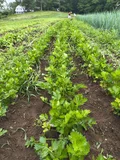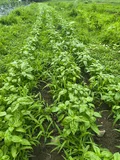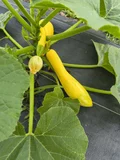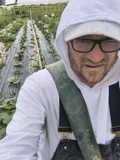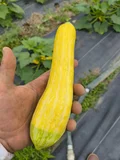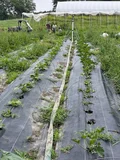TL;DR
Lots of weeding today because hashtag organic farm. Yellow summer squash are actually rolling around the fields. Basil, scallions, chard…all bountiful. Also, my personal AI now talks to me over Slack and lives in a quantum state between not-working and working.
Schrödinger’s cat is a famous thought experiment in quantum mechanics. The title of this post is a double entendre about organic farming because it also involves many unknowns until observation and action make something a known.
Surprisingly, an experimentation apparatus like a homelab with AI components exhibits similar characteristics as Erwin’s hypothetical box. Add to that the paradox of choice and a homelab feels more like a tech job I invented for myself than a fun little side project.
Experimentation in Nature
As I was sitting on the back of the big truck today riding back from the field to the barn, I had a moment of reflection about how insignificant yet at the same time wonderfully bizarre life on this planet is. I thought of the billions of other iterations of life across the universe, each grains of sand, timelapses of decomposing dead birds, and (not despite but because of all this) how important it is for us to treat each other well while we can.
Over billions of years, nature has made inconceivably numbers of experiments. Most don’t work out and very few do…but then again what does it mean to work out? If stars spiral into each other and become black holes, does that mean the experiment failed? If creatures evolve that are silicon-based, do we consider that failed because it isn’t us? If one species of basil attracts fewer pests or resists diseases than other more wild ones, does that mean it’s better?
Organic farming is a complex experiment just like the more modern synthetic and chemical approaches to agriculture. To me the key difference is that in ‘natural farming’ the same systems that made us also make organic farming possible whereas ‘invented farming’ often fails to factor multiple biological dynamics. Invented farming practices focus on narrowly-defined objectives and often ignore their broader impact on the ecosystem.
Change as a Constant
Like in our natural world, change is also a constant in the human experience. Nature tends to change on much slower timescales than our day-to-day experience and perception so its easy to take for granted long running or slowly changing eco-systemic dynamics. Even the most generous and well-intentioned of us still evolved from deeply engrained survival instincts in a world that is significantly different almost every decade. The bias towards short-term thinking is hard-wired into our brains and is often at odds with the long-term goals of sustainability.
Most modern farming practices are based on a narrow set of assumptions that were true in the 1950s but are no longer valid in the 2020s. If there was ever a time to question the status quo, it’s now. There are many situations where the phrase “what works, works” (a truism) applies in day-to-day agriculture but much of what has worked better in the recent past came from myopic, unsustainable practices.
Personal Change Management Systems
I can’t change nature, but maybe the world…? I once thought I could, even if only a little bit. Now that I’m older, I realize that the only thing I can change is myself…if that. So at least for now, changes I can make are limited to my own life and the people around me. My decisions impact myself, my family, and the community around me far more than anything I do or say in the broader world.
Change usually takes effort which takes sustained bursts of extra energy and picking the right small changes helps to keep progress sustainable. Deadlines and accountability might be helpful for some folks, but for me it usually takes a personal commitment to do something (or stop doing it) a certain new way because I have experienced the downstream impact of my own actions otherwise. Moment by moment decisions are what aggregate up to day-by-day improvement.
What about the week-to-week, the year-to-year, and beyond that? Days turn into weeks, then months, then years. If you feel that thinking beyond a few years is impractical, ask yourself what your farm succession plan is if you own your own land? If you don’t own your own land, what are your plans for the future?
The fact is that corporations have been buying up family farms and consolidating to employer-employee relationships for decades and the trend is accelerating. Fewer people who actually do the hard agricultural work have any decision-making power that is informed by connection to the land. Having any say in how the land is used, especially if you don’t own it, is increasingly difficult for the average citizen.
Co-ops and Coops to the Rescue?
Cooperatives help businesses and communities thrive by pooling resources, sharing risks, and promoting democratic decision-making. Farming cooperatives can provide a way for farmers to maintain some control over their operations and the land they work on, even if they don’t own it.
Likewise, the average citizen (not in farming) can also participate in democratic and municipal ownership by tending their own chicken coop, gardens, and participating in events and commerce associated with local agricultural cooperatives.
Especially now, a time of peril for our national agricultural support systems and federal assistance, farmers should band together in local cooperatives and experiment with new ways of working together to support each other and the land. Change is a constant, and we must adapt to survive.
My AI Is in a Superposition of Space and Time
In one way or another, I change the components of my homelab and the LLM-driven parts of my blogging process almost every week. My ‘disruption budget’ is pretty slim since I blog almost every day and need the process to just work otherwise I run out of allotted time. Since my blog is a public record of my life on the farm, I need to make sure that the process is consistent and reliable.
Last weekend I tried to short-cut a fix to a storage problem, but after 4 hours of trying to get microk8s to come back from a fraught data migration, I realized I had to start over from scratch. Space (for data storage) as it turns out, is a limited resource just as land is in farming. And just as Einstein’s general relativity showed us that energy and matter can be interconverted, the relationship between space and time can sometimes be traded on.
Case in point: dealing with a storage space constraint cost me time…low storage equals high time cost. Lots of storage equals less time dealing with space management issues. I know, on one way this is kind of a hyperbole, but in a very real way shows that two things otherwise considered unrelated might have effects on each other that can be quantified.
The effect of time on space is a function of the rate of change of one with respect to the other. As I use these daily farming experiences as idea surface area to send through my LLM, I may not have the time to change the process day-to-day, but at least I’m growing the ‘space’ upon which my future changes can operate (i.e. my own content as LLM context and training data).
Molecules want to move, especially at the quantum level. Movement is a fundamental property of matter and energy, requiring us to invent the concept of time to explain how states change. But as Douglas Adams said, “Time is an illusion. Lunchtime doubly so.” Tomorrow I will be home and not on the farm. I will be working on the process, not the content, of this blog. There is no such thing as lunchtime for me, except for when I’m on the farm.
Yesterday like every day on the farm, on my way home I recorded audio notes which were automatically uploaded to a private Google Drive folder. Immediately after I did that, ‘Autoscribe’ picked them up, transcribed them into text, then summarized them with a multi-stage summarization process going back and forth with a generic LLM (Qwen3:4b now) to produce the following summary of the day’s activities.
I had to laugh when I scanned through them and saw:
- “Document the courgette” - this post IS the documentation, but not a bad suggestion for an LLM to make. When things are this ripe, how many, and how often to check are all things that naturally farmers think about.
- “Bee in the car” - yes, as I was driving there was a huge nasty wasp in the car because I had left the windows open so that the car wouldn’t be too hot at the end of the day. Maybe I could put up some bug strips in my car to catch them.
- “a courgette…naturally rolled off the plant and landed in the intern’s pocket” - i said “it rolled off a plant…and i put it in my pocket”, but lolz okay AI whatever you need to think about how things work in the field because that would have been an amazing thing to witness.
In some ways, working with my personal AI about farming is very much like teaching it (and myself) about the natural world. I hope some day robots that take my job find this blog useful, if nothing other than as a bizarre and curious artifact of the human experience.
AI Generated Summary of Daily Notes
Final Consolidated Summary
Main Themes
- CSA Operations: Sorting, bagging, and tracking produce for CSA shares, including share equivalencies and target fulfillment.
- Fruit/Veg Handling: Managing fridge storage (e.g., swiss chard, sanitized buckets), harvesting, and temporary storage solutions.
- Harvesting & Weeding: Harvesting basil, snipping for regrowth, and weeding/trimming crops like summer squash and tomatoes.
- Irrigation & Water Management: Adjusting irrigation lines, monitoring water needs for trellised crops, and addressing system inefficiencies.
- Farm Flexibility: Adapting to variable schedules, including early departures for personal commitments.
Key Activities
- Prepared and organized CSA shares (e.g., 138 full shares).
- Moved and stored swiss chard, managed fridge inventory.
- Harvested basil, tested snipping for regrowth.
- Maintained irrigation systems, adjusted schedules for trellised crops.
- Coordinated flexible scheduling to accommodate team needs.
New Observations
- Courgette: Noted for its size and timing in crop planning.
- Florida Weave: Evaluated as a potential trellising method.
- Irrigation System: Improved efficiency through adjustments.
- Fridge Storage: Opportunities for optimization.
Key Questions
- What is the optimal irrigation schedule for trellised crops?
- How can fridge storage efficiency be improved?
- What role does the courgette play in crop planning?
- How does flexible scheduling affect team coordination?
- How effective is snipping basil for regrowth?
Suggested Actions
- Document the courgette for future reference, noting its size and timing.
- Track irrigation adjustments to ensure consistent water distribution.
- Monitor basil regrowth to assess snipping effectiveness.
- Plan CSA share targets and track half-share usage.
- Evaluate the Florida weave method for trellising efficiency and crop health benefits.
Part 1
Main Themes
- Weather and Soil Conditions: The intern notes optimal weather (70°F, overcast, light rain) and soil texture for farming activities.
- Crop Management: Weeding and pest control for celery and eggplants, emphasizing the importance of row spacing.
- Pest Control: Manual removal of potato beetles (and their larvae) without chemical pesticides.
- Volunteer Activities: Setting up a compost table for a family to volunteer and learn about farming.
- Organic Farming Practices: Emphasis on non-chemical methods (e.g., manual weeding, pest squishing) to maintain crop health.
Activities Performed by the Intern
- Weeding:
- Used a stirrup hose to weed a 300-foot celery row (60% complete).
- Weeded eggplant rows under black tarps (200-foot row with 4 rows).
- Pest Control:
- Squished potato beetles and their larvae (orange eggs, juvenile grubs) to reduce population.
- Volunteer Setup:
- Set up a compost table for a family to help with seeding trays.
- Weather and Soil Monitoring:
- Noted the impact of light rain and overcast skies on plant and soil conditions.
New Things Encountered
- Potato Beetles: Identified as a pest (orange, beetle-like, with a life cycle involving eggs, grubs, and mature beetles).
- Volunteer Composting Process: Observed a family learning to seed trays and manage compost.
- Bee in the Car: A large wasp (likely a paper wasp) was found in the car, requiring window rolling down.
- Row Spacing Importance: Realized the critical role of consistent row spacing for weeding and pest management.
Questions and Future Research
- Pest Identification: What is the exact species of the potato beetle? Could it be a different beetle (e.g., a species specific to the farm)?
- Impact of Row Spacing: How does inconsistent row spacing affect weeding and pest control efficiency?
- Manual Pest Control Efficacy: How effective is manual squishing of beetles compared to other organic methods?
- Bee Safety: What is the role of the wasp in the ecosystem, and how can the farm mitigate risks to humans and pollinators?
- Volunteer Training: How can the compost table setup be optimized for educational purposes?
Suggested Actions
- Monitor Pest Population: Track the number of potato beetles over time to assess the effectiveness of manual control.
- Improve Row Spacing: Adjust row spacing for celery and eggplants to simplify weeding and pest management.
- Document Bee Incident: Investigate the source of the wasp (e.g., nearby habitat) and implement measures to prevent future encounters.
- Develop a Pest Control Guide: Create a resource for farm staff on identifying and managing pests like potato beetles.
- Enhance Volunteer Training: Provide clearer instructions for the family on composting and seed tray management.
Part 2
Main Themes:
- CSA Preparation and Management: Preparing and organizing produce for the CSA, including sorting, bagging, and tracking share equivalencies.
- Fruit and Veggie Storage/Handling: Managing fridge space, moving chard, and using sanitized buckets for temporary storage.
- Harvesting and Crop Management: Harvesting basil, snipping for regrowth, and targeting specific yields for the CSA.
- Irrigation and Crop Care: Moving irrigation lines, weeding summer squash, and managing water needs for trellised tomatoes.
- Farm Flexibility and Scheduling: Adapting to flexible work hours, including picking up people or managing time for personal commitments.
Activities Performed:
- Prepared and organized CSA order bags, including sorting and bagging produce.
- Moved and reorganized swiss chard and other produce in the fridge using sanitized blue buckets and tote bins.
- Harvested and snipped basil for regrowth, targeting 50 bunches for the week.
- Managed irrigation lines in the middle field, weeding summer squash and tomatoes.
- Documented a courgette that rolled into the intern’s lap, noting its beauty and size.
- Helped with trellising tomatoes using the “Florida weave” method.
- Adjusted to a flexible schedule, including an early departure for a personal commitment.
New Things Encountered:
- A courgette (yellow summer squash) that naturally rolled off the plant and landed in the intern’s pocket.
- The Florida weave technique for trellising tomatoes (a specific method for vertical growth).
- A unique irrigation system requiring line adjustments and water management.
- The timing of rain (first significant rain in ~2 weeks) and its impact on crop needs.
Questions and Future Research:
- How does the basil regrowth (snipping for future harvests) affect overall yield and timing?
- What is the optimal water schedule for trellised tomatoes and summer squash during dry periods?
- How does the fridge space management (e.g., blue buckets vs. tote bins) impact long-term storage efficiency?
- What is the specific role of the courgette in the farm’s crop rotation or seasonal planning?
- How does the flexible schedule (e.g., early departures) affect farm operations or team coordination?
Suggested Actions:
- Document the courgette as a unique find and note its size and timing for future reference.
- Track irrigation line adjustments to ensure consistent water distribution for crops.
- Monitor basil regrowth to evaluate effectiveness of snipping for future harvests.
- Plan for CSA share equivalencies to ensure targets (138 full shares) are met, including tracking half-share usage.
- Evaluate the Florida weave method for trellising tomatoes to determine its efficiency and crop health benefits.
[end of post]
Enjoy Reading This Article?
Here are some more articles you might like to read next:
